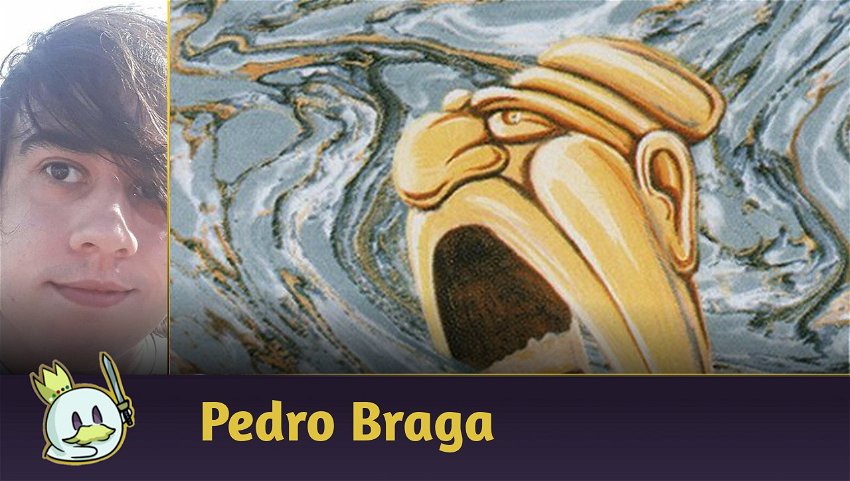Out of all types of Magic cards, one of them has always stood out, since the very beginning, because of its countless powerful cards, and many possible interactions, besides the various support options. Unfortunately, not every artifact can be the next Black Lotus, and, sometimes, they can't even be an Aesthir Glider.
In today's article, we'll discuss the worst artifacts ever printed in the history of Magic: The Gathering. These cards are so far from an efficient game strategy that they aren't even worth the materials used to print them.
As usual, this list isn't necessarily ordered, and instead, we'll just go over these artifacts and discuss some weird, different cards with a bit more fun.
Amulet of Quoz

A long time ago, there was a rule in MTG that made players bet with each other - each player bet the top card in their deck, and whoever won the match would take those cards home. The extinct Ante-Rule would take place after each player drew their initial hand. The top eighth card on their deck was removed and placed in the "ante zone" as part of their bet.
This rule was removed from the game because of a few reasons. The main one, of course, is that the game's association with betting would eventually change its age rating, and the entire market they were targeting, as it would make it closer to plain gambling. Another frequent complaint was how these bets were unequal, as they could be decided entirely on luck. Like so, the top card in your opponent's deck might as well be a simple Forest, while you may end up betting a valuable card, like a Mox, or Black Lotus itself.
That being said, we have Amulet of Quoz, a card that focuses on turning a bet in a Magic: The Gathering game into a plain gamble, considering it puts the fate of the match entirely on a coin toss. And, there's also something about it that can even be considered worse, or better - the opponent in question can bet even more cards from the top of their deck to counter this effect.
Amulet of Quoz isn't only bad because it works with a problematic, and even controversial, mechanic for the health of the game as a product; it is also bad because it creates another reason for this game to be called a "gambling game". With this card, the game truly focused on betting cards, which reduced all MTG matches into a game that only works with probability and chance (not skill), and allowed players to even increase their bets. It is definitely a card limited to its time.
Goblin Lyre

Still on the subject of "gambling", Goblin Lyre not only depends on a 50/50 chance, but it also depends on how many creatures you have on the board. So, you can deal a significant amount of damage or take a significant amount of damage, according to the creatures on your opponent's board.
Obviously, the idea is to use this card when you have a lot of creatures and your opponent has none. You know what else is great in a situation like this? Just attacking with all your creatures.
Goblin Lyre simply offers us a considerable amount of damage if we win our coin toss. It may even be a very fun card, but sometimes (just) attacking, an action that happens every turn and doesn't cost any mana, is a much better option.
Balm of Restoration

There is a card cycle in Alpha that does 3 of something for one mana of each specific color. The blue version is Ancestral Recall, which draws three cards for one mana, and the red one is Lightning Bolt, which deals three damage for one mana, and so on and so forth. The worst card in this cycle is the white version, Healing Salve, which heals 3 life or prevents 3 points of damage.
We could spend a lot of time discussing why gaining life isn't the best ability, or why 3 life is not enough for one mana, and try to calculate an arbitrary value of what is the best ratio between mana and life gained, but the point is:
Balm of Restoration can be sacrificed to give you 2 life, or prevent 2 damage, for three mana. That is one less life gained for triple what Healing Salve costs. Not even the most desperate player would use such a card to gain life.
And, of course, the worst thing about Balm of Restoration is that it can be destroyed before you can even have enough mana to activate its ability, which means, you'll lose two mana without even gaining your incredible 2 life.
Juju Bubble

Juju Bubble, unlike Balm of Restoration, can be used continuously, without requiring you to sacrifice an artifact, to gain as much life your mana allows you to. Considering we've just seen one of the mediocre cards of all time, Balm of Restoration, this opportunity may even seem like a dream, but, actually, it is full of restrictions.
On one hand, Juju Bubble has a cumulative upkeep cost of 1. Which means, at your first upkeep with it on the board, you'll pay 1 mana, then on the second one pay 2, then on the third one pay 3, and so on and so forth. Either you pay mana, or this card is destroyed. This easily consumes the mana you'd use to gain life with this incredibly unfair, overpowered, (/s) artifact.
Additionally, playing cards forces you to sacrifice Juju Bubble. Yes, playing, and not casting, which restricts even the simplest action in the game: playing lands. But it's okay. If we can gain one life for two mana, why would we ever want to play more cards, right?
Rakalite

What could be worse than Balm of Restoration? Simple, spending 6 mana on an artifact that allows you to spend two mana to prevent 1 miserable damage. I could make several jokes, say that I'd rather someone take two hammers and use my ribs as a xylophone, but not even all my comedy skills are worth discussing this card for.
We could argue that, with mana engines that offer us absurd amounts of resources, this artifact can start to make some sense, but the worst part comes now: after activating this ability at least once, Rakalite returns to your hand at the end of the turn, which will force you to spend 6 mana on your next turn to play it, and then wait for the opportunity to spend two mana to prevent one damage.
They say The Rack feels like medieval torture, but, to me, Rakalite is the closest to replicating that Magic has ever gotten.
Illusionary Mask

Morph has always been relatively mediocre for a mechanic. It is expensive, has little to no payoff, and it is incredibly slow. Still, placing a card face down with this mechanic, or with Disguise, costs only 3 mana, whereas Illusionary Mask forces you to pay at least mana enough to cast the creature in question.
That's when we create a weird situation involving bluff, risk, and reward. You might as well spend ten mana and place that Llanowar Elves face down as a 2/2 creature, which would be bluffing and overall manipulative. By attacking, your opponent can decide how to block, considering the type of card that might be face down, and then, when it's time to deal damage, be it to other creatures or to your opponent, you turn the creature face up and deal damage. In this example, we spent ten mana to deal 1 damage to our opponent, but, see, we did that through some incredible mental gymnastics, worthy of the greatest manipulative master you've ever seen.
Illusionary Mask is more interesting and mechanically fascinating than actually good. The fun of it is in trying to find the perfect balance between the mana spent and the creature placed face down, but, other than that, it is just an artifact with a weird mechanic that doesn't do much.
Razor Boomerang

Remember everything I said earlier about Balm of Restoration? Razor Boomerang is the same, if not worse.
It costs three mana to cast, and two to equip. All this to give you the option of tapping the equipped creature and dealing 1 damage. Of course, pingers have always been interesting creatures in the history of Magic, and can form entire strategies, but none of them are an artifact that costs five mana, taps a creature, and returns to their owner's hand after dealing a single point of damage.
Razor Boomerang delivers such a mediocre execution that there is nothing fun about it. There are no jokes to be made because the card itself is the joke. Next time someone comes to you and asks you to tell them something funny, just say Razor Boomerang.
Arcum's Sleigh

This is another card that appears to have been specifically made to drive me crazy; Arcum's Sleigh also costs way more mana than necessary to do something that should be more usual in the game.
As Lance has already taught us, it isn't expensive to give Vigilance to a creature for good. However, Arcum's Sleigh tries to reinvent the wheel by costing two mana to give that ability to a creature until the end of the turn. The worst of all is: this ability doesn't work unless your opponent controls snow lands. Because, of course, Arcum's Sleigh is still a sleigh. It even has an angry goat in its artwork.
In most formats, it is incredibly rare to see this type of land, so this fine example of a vehicle you'd use to move around snowy alps simply makes zero sense.
Armageddon Clock

Now, this is the time when my indignation becomes physical pain. For six full mana, Armageddon Clock goes on the battlefield and starts stacking "Doom Counters", a concept as macabre as a dark, Ben 10 fanfic your classmate wrote in eighth grade and made sure to tell you all about the next day.
But don't be mistaken. Doom Counters can cause a lot of pain to all players, at the same time. More precisely, one damage for each counter at the beginning of your draw step.
If I'm a control player, it seems like a good idea. I keep gaining life, slow down the game, and gradually deal damage to my opponent. But, of course, any player can spend four mana to remove one of these counters from the board.
And that's when we start asking ourselves: "Why?" What would any player gain from spending mana to remove these counters? Why would I spend six mana to cast an easily reversible spell that will deal damage to me gradually in exchange for nothing? Why am I playing a cardboard card game on a Friday night when I could be studying for med school like my parents wanted, and building a family, which would fill me up with love and cure my seasonal depression, which I feel creeping under my skin every night before bed?
Armageddon Clock creates a lot of questions, and the main one is why would someone spend four mana to remove a counter, if we can use Disenchant, which costs two mana, and remove all of them.
Anti-Set Artifacts

City in a Bottle, Apocalypse Chime, and Golgothian Sylex are all artifacts that have a goal greater than just driving me mad; they want to destroy entire sets, in particular.
With any of these artifacts on your board, we can get rid of many cards, as long as they are from a specific set. Apocalypse Chime and Golgothian Sylex cost mana to destroy cards from Homelands and Antiquities, respectively. City in a Bottle is much more aggressive because it has a static ability that forces players to sacrifice cards with a name originally printed in the Arabian Nights, and doesn't let players cast those cards while it is on the board.
Of course, such effects, are, in a way, quite strong, and most players can think of a set they want to destroy in a similar way. The problem is: Antiquities, Homelands, and Arabian Nights are three sets that didn't really impact the game, and, even if you face cards from one of them, such as Antiquities cards, which are played in Vintage's Shops, using any of these artifacts is still far from being an option.
So, we have three artifacts with an interesting design, but, unfortunately, they were heavily punished by how irrelevant their targets are.
Final Words
I always enjoy writing articles about this type of theme because it challenges me to create content that is unusual for me, and just have a bit more fun with it.
Unfortunately, as the game is becoming more and more modern and requires cards that actually do something, we'll rarely see "fun cards, full of personality", like the ones above, again.
Maybe, one day, Wizards of the Coast can reprint a new Razor Boomerang by accident.
See you next time!














— Comentarios 0
, Reacciones 1
Se el primero en comentar